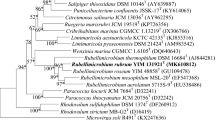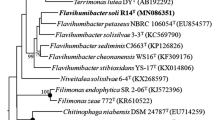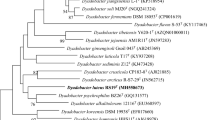Abstract
A novel pink-coloured, non-spore-forming, non-motile, Gram-negative bacterium, designated YIM 48858T, is described by using a polyphasic approach. The strain can grow at pH 6.5–9 (optimum at pH 7) and 25–30°C (optimum at 28°C). NaCl is not required for its growth. Positive for oxidase and catalase. Urease activity, nitrate reduction, starch and Tween 80 tests are negative reaction. 16S rRNA gene sequence similarity studies showed that strain YIM 48858T is a member of the genus Rubellimicrobium, with similarities of 96.3, 95.7 and 95.5% to Rubellimicrobium mesophilum MSL-20T, Rubellimicrobium aerolatum 5715S-9T and Rubellimicrobium thermophilum DSM 16684T, respectively. Q-10 was the predominant respiratory ubiquinone as in the other members of the genus Rubellimicrobium. The major polar lipids were diphosphatidylglycerol, phosphatidylcholine, phosphoglycolipid, glycolipid and the major fatty acids were C18:1 ω7c, C16:0 and C10:0 3-OH, which are very different from the valid published species. The DNA G + C content was 67.7 mol%. Both phylogenetic and chemotaxonomic evidence supports that YIM 48858T is a novel species of the genus Rubellimicrobium, for which the name Rubellimicrobium roseum sp. nov. is proposed. The type strain is YIM 48858T (=CCTCC AA 208029T =KCTC 23202T).

Similar content being viewed by others
References
Chun J, Lee JH, Jung Y, Kim M, Kim S, Kim BK, Lim YW (2007) EzTaxon: a web-based tool for the identification of prokaryotes based on 16S ribosomal RNA gene sequences. Int J Syst Evol Microbiol 57:2259–2261
Cowan ST, Steel KJ (1965) Manual for the identification of medical bacteria. Cambridge University Press, London
Dastager SG, Lee JC, Ju YJ, Park DJ, Kim CJ (2008) Rubellimicrobium mesophilum sp. nov., a mesophilic, pigmented bacterium isolated from soil. Int J Syst Evol Microbiol 58:1797–1800
Denner EBM, Kolari M, Hoornstra D, Tsitko I, Kämpfer P, Busse HJ, Salkinoja-Salonen M (2006) Rubellimicrobium thermophilum gen. nov., sp. nov., a red-pigmented, moderately thermophilic bacterium isolated from coloured slime deposits in paper machines. Int J Syst Evol Microbiol 56:1355–1362
Doetsch RN (1981) Determinative methods of light microscopy. In: Gerhardt P, Murray RGE, Costilow RN, Nester EW, Wood WA, Krieg NR, Phillips GH (eds) Manual of methods for general bacteriology. American Society for Microbiology, Washington, DC, pp 21–33
Felsenstein J (1981) Evolutionary trees from DNA sequences: a maximum likelihood approach. J Mol Evol 17:368–376
Felsenstein J (1985) Confidence limits on phylogenies: approach using the bootstrap. Evolution 39:783–791
Fitch WM (1971) Toward defining the course of evolution: minimum change for a specific tree topology. Syst Zool 20:406–416
Gauze GF, Preobrazhenskaya TP, Sveshnikova MA, Terekova LP, Maksimova TS (1983) Opredelitel’ Aktinomycetov: Rody Streptomyces, Streptoverticillium, Chainia. Izd. Nauka, Moscow (in Russian)
Gregersen T (1978) Rapid method for distinction of Gram-negative from Gram-positive bacteria. Eur J Appl Microbiol Biotechnol 5:123–127
Jiang Y, Tang SK, Wiese J, Xu LH, Imhoff F, Jiang CL (2007) Streptomyces hainanensis sp. nov., a novel member of the genus Streptomyces. Int J Syst Evol Microbiol 57:2694–2698
Kämpfer P, Kroppenstedt RM (1996) Numerical analysis of fatty acid patterns of coryneform bacteria and related taxa. Can J Microbiol 42:989–1005
Kimura M (1980) A simple method for estimating evolutionary rates of base substitutions through comparative studies of nucleotide sequence. J Mol Evol 16:111–120
Komagata K, Suzuki K (1987) Lipid and cell-wall analysis in bacterial systematics. Methods Microbiol 19:161–207
Kumar S, Tamura K, Nei M (2004) MEGA3: integrated software for molecular evolutionary genetics analysis and sequence alignment. Brief Bioinform 5:150–163
Leifson E (1960) Atlas of bacterial flagellation. Academic Press, London
Li WJ, Xu P, Schumann P, Zhang YQ, Pukall R, Xu LH, Stackebrandt E, Jiang CL (2007) Georgenia ruanii sp. nov., a novel actinobacterium isolated from forest soil in Yunnan (China) and emended description of the genus Georgenia. Int J Syst Evol Microbiol 57:1424–1428
Marmur J (1961) A procedure for the isolation of deoxyribonucleic acid from microorganisms. J Mol Biol 3:208–218
Mesbah M, Premachandran U, Whitman WB (1989) Precise measurement of the G + C content of deoxyribonucleic acid by high-performance liquid chromatography. Int J Syst Bacteriol 39:159–167
Minnikin DE, O’Donnell AG, Goodfellow M, Alderson G, Athalye M, Schaal A, Parlett JH (1984) An integrated procedure for the extraction of isoprenoid quinines and polar lipids. J Microbiol Methods 2:233–241
Saitou N, Nei M (1987) The neighbor-joining method: a new method for reconstructing phylogenetic trees. Mol Biol Evol 4:406–425
Smibert RM, Krieg NR (1994) Phenotypic characterization. In: Gerhardt P, Murray RGE, Wood WA, Krieg NR (eds) Methods for general and molecular bacteriology. American Society for Microbiology, Washington, DC, pp 607–654
Stevenson IL (1967) Utilization of aromatic hydrocarbons by Arthrobacter spp. Can J Microbiol 13:205–211
Thompson JD, Gibson TJ, Plewniak F, Jeanmougin F, Higgins DG (1997) The CLUSTAL_X windows interface: flexible strategies for multiple sequence alignment aided by quality analysis tools. Nucleic Acids Res 25:4876–4882
Tsukamura M (1966) Adansonian classification of mycobacteria. J Gen Microbiol 45:253–273
Weon HY, Son JA, Yoo SH, Hong SB, Jeon YA, Kwon SW, Koo BS (2009) Rubellimicrobium aerolatum sp. nov., isolated from an air sample in Korea. Int J Syst Evol Microbiol 59:406–410
Acknowledgements
This research was supported by the National Natural Science Foundation of China (No. 30900002 and No. 30560001), International Cooperative Key Project of Ministry of Science and Technology (2006DFA33550). Authors are grateful to Yong-Xia Wang, Yun Wang and Yun Chen for their help in technique.
Author information
Authors and Affiliations
Corresponding author
Additional information
The GenBank/EMBL/DDBJ accession number for the 16S rRNA gene sequence of strain YIM 48858T is GU109478.
Rights and permissions
About this article
Cite this article
Cao, YR., Jiang, Y., Wang, Q. et al. Rubellimicrobium roseum sp. nov., a Gram-negative bacterium isolated from the forest soil sample. Antonie van Leeuwenhoek 98, 389–394 (2010). https://doi.org/10.1007/s10482-010-9452-2
Received:
Accepted:
Published:
Issue Date:
DOI: https://doi.org/10.1007/s10482-010-9452-2




